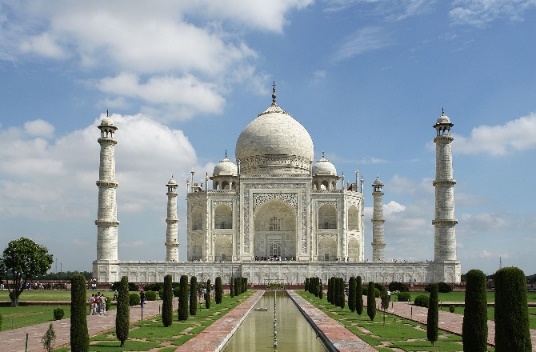17 THE INDIAN SUBCONTINENT
The sons of Akbar, Jahangir and Shah Jahan, inherited his vast empire but lacked his exceptional administrative skills. Jahangir, who ruled from 1605 to 1627, was a weak and ineffective leader, plagued by alcoholism and a lack of interest in governance. His reign was marked by power struggles among courtiers and nobles, which weakened the empire’s stability. Additionally, Jahangir’s policies towards the Sikhs and other religious groups were more restrictive than his father’s, leading to increased tensions. Overall, Jahangir’s reign was marked by a decline in the empire’s fortunes.
In contrast, Shah Jahan, who ruled from 1628 to 1658, was a more effective ruler who continued his father’s tolerant policies. He was deeply in love with his wife, Mumtaz Mahal, and built the iconic Taj Mahal as a tribute to her after her death in 1631. This magnificent monument showcased the Mughal Empire’s architectural prowess and became a symbol of India’s rich cultural heritage. Shah Jahan’s reign also saw significant economic growth, with the establishment of new trade routes and the expansion of the empire’s agricultural base. Furthermore, Shah Jahan’s court was renowned for its cultural achievements, including literature, music, and art.

During Shah Jahan’s reign, India experienced a period of unprecedented prosperity and prestige. However, this was also a time of great challenges, including one of the worst famines in Indian history, which occurred in 1630-31 and claimed hundreds of thousands of lives. The famine was exacerbated by a shortage of copper, which led to a decline in copper coinage and a shift towards silver currency. Additionally, the empire faced external threats from the Uzbeks and the Persians, which required significant military expenditure. Despite these challenges, Shah Jahan’s reign is remembered as a golden age in Indian history.
For ordinary people, life in 17th-century India was marked by social hierarchies and gender roles. A notable example is the life of Jahanara Begum, the daughter of Shah Jahan and Mumtaz Mahal. Despite being a woman in a patriarchal society, Jahanara Begum wielded significant influence as the de facto ruler of the Mughal Empire during her father’s imprisonment. She managed the imperial household, oversaw the construction of several architectural projects, and even issued imperial orders. Additionally, Jahanara Begum was a patron of the arts and literature, and her court attracted scholars and poets from across the empire.
By the end of the 17th century, the Mughal administration was in decline, and the empire faced numerous challenges. Military leaders from the former Hindu kingdom of Maharashtra waged war on the Deccan and eastern provinces, while previous Mughal allies, such as the Rajputs, Sikhs, Jats, and Satnamis, rebelled against the empire. The empire’s finances were also in disarray, with a significant decline in revenues and a growing debt burden. Furthermore, the Mughal court was plagued by factionalism and corruption, which weakened the empire’s ability to respond to external threats. Overall, the Mughal Empire was in a state of crisis by the late 17th century.
The decline of the Mughal Empire also created opportunities for European companies to establish themselves in India. The Portuguese, who had previously maintained a dominant position in Indian trade for over a century, began to experience a decline in their commercial influence. Meanwhile, the Dutch, English, French, and Danish established coastal trading centers, capitalizing on the lucrative exportation of commodities such as textiles, sugar, indigo, and salt. The European presence brought new technologies, including the printing press and firearms, which had varying effects on Indian society. However, the impact of these technologies must be viewed alongside the resilience and adaptations of Indian states and societies. Local powers, such as the Marathas, Sikhs, and regional sultanates, also played crucial roles in shaping the political and economic environment. Their resistance to Mughal authority and engagement with European traders were significant in the broader narrative of India’s transformation during this period.
In the northern Punjab region, the Sikh gurus, spiritual leaders of the Sikh community, sought to harmonize the principles of Islam and Hinduism, shaping the foundations of Sikhism. This pursuit culminated in 1604 with the completion of the Guru Granth Sahib, a sacred text compiling the teachings of Sikh gurus and revered spiritual leaders. The Guru Granth Sahib represented the culmination of Sikh revelation, and its authority was solidified in 1699 by Guru Gobind Singh, the tenth Sikh Guru. He formally declared the text the ultimate scripture of Sikhism and established the Khalsa, a martial brotherhood of initiated Sikhs dedicated to protecting their faith and community. This marked a significant milestone in Sikh history, as the Khalsa had a profound impact on the community’s future.
